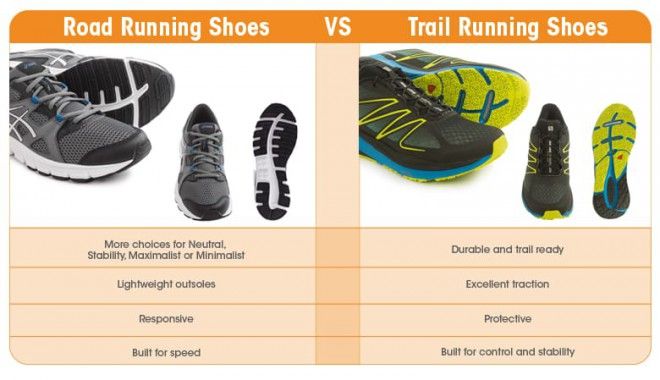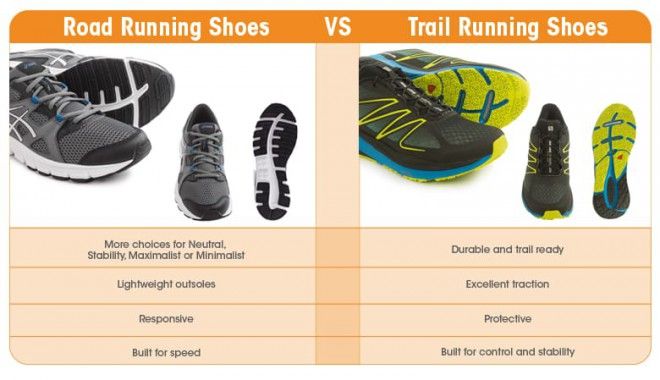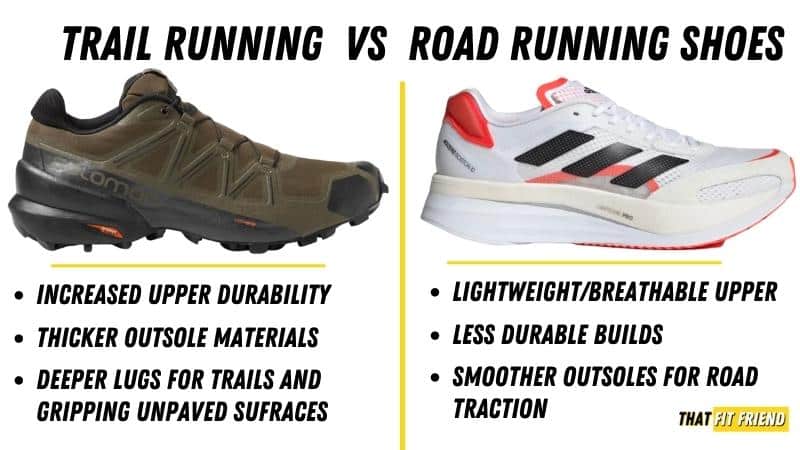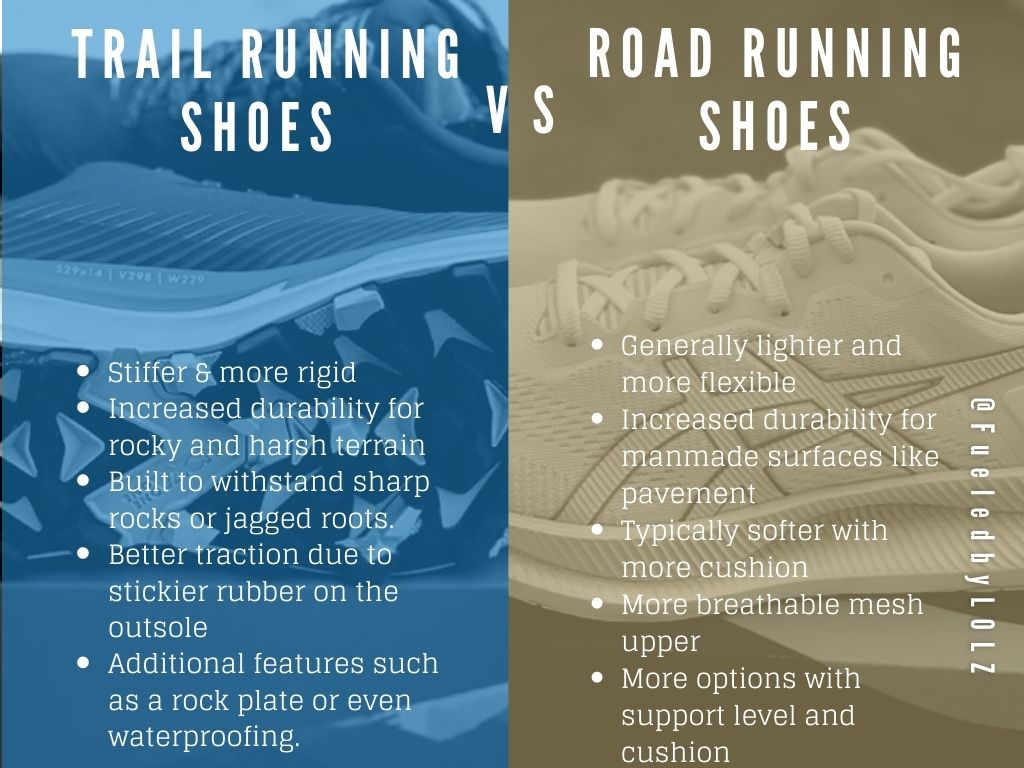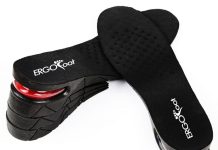So, you’re a runner, huh? Whether you pound the pavement or prefer to conquer the trails, one thing’s sure – the shoes on your feet can make all the difference.
But have you ever stopped to wonder what sets road running shoes apart from their trail running counterparts?
Well, wonder no more! This article will explore the critical distinctions between these two running shoes, helping you find the perfect fit for your preferred terrain.
Lace-up your shoes and get ready to hit the ground running!
Materials
Upper
The upper of a running shoe is the part that covers the top of your foot. In road and trail running shoes, the upper is typically made of lightweight and breathable materials such as mesh or synthetic fabrics.
However, some differences exist in constructing the upper road and trail shoes.
Road running shoes often have a more streamlined and aerodynamic design. The upper is usually lighter and more flexible, allowing for a more excellent range of motion and enhanced speed on smooth surfaces. It is also designed to provide a snug fit, ensuring your foot stays securely in place during your runs on paved roads.
On the other hand, trail running shoes have a more rugged and durable upper. They are designed to withstand the harsh conditions encountered in off-road running, such as uneven terrain, rocks, and debris.
The upper is often made of more rigid materials and may feature overlays or reinforcements to provide additional protection and support. This helps to prevent injuries and keep your feet comfortable and stable while navigating challenging trails.
Midsole
A running shoe’s midsole is the material layer between the upper and the outsole. It is crucial in providing cushioning, support, and stability during your runs.
In road running shoes, the midsole is usually made of lightweight and responsive foam. It is designed to absorb the impact forces generated by each footstrike on hard surfaces, such as pavements or sidewalks.
The cushioning in road shoes tends to be softer and more forgiving, allowing for a smoother and more comfortable ride over long distances.
Trail running shoes, on the other hand, have a more robust and protective midsole. The cushioning is typically firmer and more responsive, as it needs to provide ample support and stability on uneven and unpredictable terrains.
The midsole in trail shoes often features technologies like rock plates or reinforced foam to protect your feet from sharp rocks or roots that you may encounter on the trails.
Outsole
The outsole of a running shoe is the part that comes into direct contact with the ground. It provides traction and grip, ensuring stability and control during your runs.
Road running shoes generally have a smooth and flat outsole pattern. This design allows maximum contact with the ground on even surfaces, optimizing efficiency and speed. The outsole is usually made of a durable rubber compound that provides sufficient grip on asphalt or concrete roads.
In contrast, trail running shoes have a more aggressive and multi-directional lug pattern on the outsole. The lugs are deeper and more widely spaced to enhance traction on various terrains, including mud, gravel, and loose dirt.
The outsole is often made of a stickier rubber compound that can grip slippery surfaces and provide better traction on uneven trails.
Traction
Road Running Shoes
Road running shoes are designed for traction on smooth surfaces such as paved roads, sidewalks, or tracks. The outsole of road shoes features a smooth and flat pattern, allowing maximum ground contact and optimal running efficiency.
The rubber compounds used in road shoes are designed for durability and grip on hard surfaces, ensuring that you can maintain stability and control during your road runs.
Trail Running Shoes
Trail running shoes are built to handle the challenges of off-road running, where traction is essential on uneven and unpredictable terrains.
The outsole of trail shoes features a more aggressive lug pattern, with deeper and widely spaced lugs that provide enhanced grip and traction on various surfaces. The rubber compounds in trail shoes are often stickier to ensure better traction on wet or slippery trails.
Choosing the right shoe that suits your terrain and running style is essential whether you prefer road or trail running.
Road running shoes may not provide adequate traction on trails, while trail running shoes may be overly rugged and heavy for road running. Consider the conditions and surfaces you will be running on to make an informed decision about the traction requirements of your running shoes.
Cushioning
Road Running Shoes
Road running shoes prioritize cushioning to absorb the impact forces generated by each foot strike on hard and repetitive surfaces. The midsole of road shoes usually contains soft and responsive foams, providing a plush and comfortable ride.
The cushioning in road shoes reduces the stress and strain on your joints, allowing more extended and more comfortable runs. Many road shoes also feature additional technologies, such as gel cushions or air pockets, to enhance the shock-absorbing properties of the shoe.
Trail Running Shoes
Trail running shoes also offer cushioning, but with a different emphasis. The midsole of trail shoes is typically firmer and more responsive, providing a stable platform to support your feet on uneven and challenging terrains.
The cushioning in trail shoes is designed to protect your feet from the impact of rocks or roots while providing enough responsiveness for agility and maneuverability. Some trail shoes may incorporate rock plates or reinforced foam to offer additional protection on rugged trails.
The choice of cushioning in your running shoes depends on your preferences and the terrain you will be running on.
If you primarily run on paved roads or other hard surfaces, road running shoes with softer cushioning may be more suitable. If you enjoy off-road adventures on rocky or uneven trails, trail running shoes with firmer cushioning and added protection would be more appropriate.
Support
Road Running Shoes
Road running shoes provide support primarily through the shoe’s overall structure and design. The upper of road shoes is typically designed to provide a snug and secure fit, keeping your foot in place during each stride.
This helps to prevent excessive movement or pronation, enhancing stability and reducing the risk of injuries. Many road shoes also incorporate heel counters or arch support systems to provide additional support and alignment for your feet.
Trail Running Shoes
Trail running shoes prioritize support to withstand the challenges of off-road running. The upper of trail shoes is usually more rugged and durable, with overlays or reinforcements to protect your feet from rocks, debris, or lateral movements on uneven terrains.
These added features offer stability and protection, reducing the risk of rolled ankles or twisted feet. Some trail shoes may have a more pronounced heel cup or counter to enhance support and stability in demanding trail conditions.
When choosing between road and trail running shoes, consider your pronation tendencies, arch type, and any specific support needs you may have.
Road running shoes with suitable support features can be a good choice if you require additional stability due to overpronation or low arches.
If you need extra protection and support for rugged trails, trail running shoes with a more supportive upper and added stability features may be the better option.
Stability
Road Running Shoes
Road running shoes aim to stabilize predictable surfaces such as roads and pavements. The design of road shoes focuses on minimizing excessive side-to-side movements and ensuring a smooth and controlled stride.
The broader and more stable base of road shoes helps to maintain balance and prevent unnecessary rolling or twisting of the foot.
Trail Running Shoes
Trail running shoes are specially designed to offer stability on uneven and challenging terrains. The outsole of trail shoes typically has a broader footprint, providing a stable platform to tackle uneven surfaces or obstacles.
The rugged upper construction with overlays and reinforcements also helps to keep your foot securely in place and prevent lateral movements.
If your running routine involves primarily road running on well-maintained surfaces, road running shoes with stability features would be sufficient.
However, if you enjoy off-road adventures and trail running, choosing trail running shoes with additional stability features like a wider outsole or a more supportive upper can help you maintain better balance and stability on unpredictable terrains.
Weight
Road Running Shoes
Weight is essential in road running shoes, as lighter shoes can help improve speed and running efficiency. Road running shoes are generally designed to be lightweight and streamlined, with minimal extra weight.
These shoes prioritize weight reduction for a more natural and efficient stride on smooth surfaces. The lightweight construction of road shoes also aids in reducing fatigue during longer road runs.
Trail Running Shoes
Trail running shoes tend to be slightly heavier than their road counterparts due to the added durability and protection required for off-road running.
The rugged construction adds weight to the shoe, including the more durable upper, protective elements, and aggressive outsole. However, the added weight in trail shoes is necessary to provide stability, support, and protection on challenging trails.
Consider the running you will be doing when assessing the weight of your running shoes. Lightweight road running shoes would be the better option if you prioritize speed and efficiency on flat and predictable surfaces.
If you plan to tackle rugged and varied terrains, investing in slightly heavier trail running shoes would provide the protection and durability required for off-road adventures.
Durability
Road Running Shoes
Durability is essential when choosing road running shoes, as they can be subjected to consistent and repetitive impact on hard surfaces. Road running shoes are built to withstand the wear and tear of pavement running.
They often feature durable rubber outsoles that endure high mileage and resist abrasions from road surfaces. Additionally, the upper materials of road shoes are chosen for their durability to ensure longevity.
Trail Running Shoes
Trail running shoes are designed to handle the more demanding and rugged conditions encountered in off-road running. They are built with added durability features to withstand the challenges of unpaved trails, rocky terrains, and debris.
The outsole of trail shoes is made from a more durable rubber compound that can withstand the abrasive surfaces found on trails. The upper materials are also chosen for their durability and resistance to damage from rocks or branches.
Due to the more intense nature of trail running, trail shoes typically have a longer lifespan when compared to road running shoes.
If you frequently engage in trail running, investing in a pair of durable trail running shoes will ensure they can withstand the demands of the terrain and provide long-lasting performance.
Flexibility
Road Running Shoes
Flexibility is an essential characteristic of road running shoes to allow for a natural and efficient stride on smooth surfaces.
The design of road shoes emphasizes flexibility to accommodate the forward motion of running and promote a smooth transition from heel to toe. The upper materials and construction of road shoes are chosen to provide a flexible and forgiving fit, allowing your foot to move naturally without restrictions.
Trail Running Shoes
While flexibility is still necessary for trail running shoes, it must be balanced with the required stability and protection for off-road running.
Trail shoes often have a slightly stiffer construction to offer more support on challenging terrains.
The midsole and outsole are engineered to provide a stable platform while navigating uneven surfaces. However, trail shoes still prioritize enough flexibility to allow for a responsive and agile performance on the trails.
When choosing between road and trail running shoes, consider your preference for flexibility and the types of terrain you will be running on.
Road running shoes would be better if you enjoy a more flexible and natural feel during your runs. If you require a balance of flexibility and trail-specific features for off-road running, trail running shoes would be more suitable.
Protection
Road Running Shoes
Road running shoes prioritize lightweight construction and efficiency, which may result in less emphasis on protection. While road shoes offer cushioning and comfort, their design usually doesn’t include extensive protective features.
The focus is on creating a lightweight, responsive shoe for smooth surfaces. However, road shoes may still have some essential protective elements, such as reinforced toe caps to protect against minor impacts or debris on the roads.
Trail Running Shoes
Trail running shoes emphasize protection more due to the rugged and unpredictable nature of off-road running. The construction of trail shoes is designed to protect your feet from various hazards encountered on the trails.
The upper is typically more durable and may feature toe guards or rock plates to shield your feet from sharp rocks or roots. The outsole pattern and rugged materials provide grip and protect your feet from uneven terrains and small debris.
Road running shoes with minimal protective features would be sufficient if you primarily run on well-maintained surfaces.
However, if you venture onto trails with rocks, roots, or other obstacles, investing in trail running shoes with added protection can significantly reduce the risk of injuries and ensure a safer and more enjoyable off-road experience.
Price
Road Running Shoes
Road running shoes are generally more affordable than trail running shoes. This is primarily because road shoes often have simpler and lighter constructions without the need for extra durability or protective features.
The materials and technologies used in road shoes are geared towards smoother surfaces and speed, which can help to keep the costs down. Depending on the brand and specific model, road running shoes can range from budget-friendly options to higher-priced models with advanced features.
Trail Running Shoes
Trail running shoes, however, often come with a higher price tag due to their more complex construction and added durability and protective features. The specialized materials and technologies required to withstand the challenges of off-road running contribute to the increased cost.
Additionally, trail shoe outsole design, material quality, and upper construction are engineered for more rugged terrains, which can impact the overall price. Trail running shoes can span various prices, from affordable options to high-end models with advanced trail-specific features.
When considering the price of running shoes, weighing the features and requirements related to your running style and preferred terrains is essential.
While road running shoes may be more budget-friendly, investing in trail running shoes with the necessary protection and durability can be wise if you frequently engage in off-road adventures.
It is also important to remember that purchasing a higher-quality and more durable shoe can save you money in the long run by providing longevity and reducing the risk of injuries.
In conclusion, road and trail running shoes have distinct differences in their materials, traction, cushioning, support, stability, weight, durability, flexibility, protection, and price.
Understanding these differences can help you choose the appropriate running shoes for your preferred terrain and running style.
Remember to prioritize comfort, fit, and the specific needs of your feet when choosing your running shoes, as these factors are crucial for a successful and enjoyable running experience.
So lace up your shoes, hit the road, or venture onto the trails – happy running!

